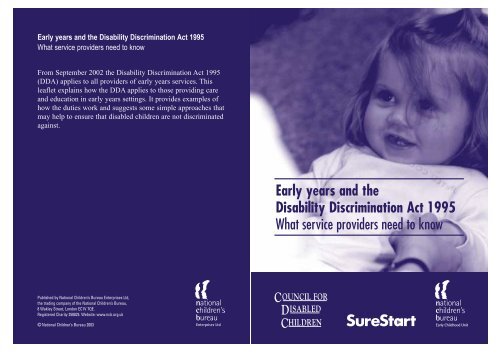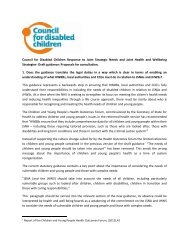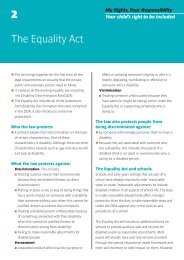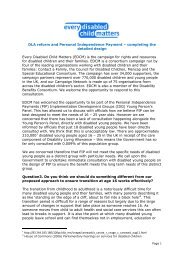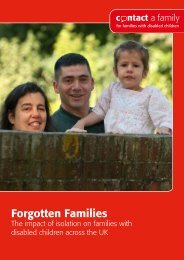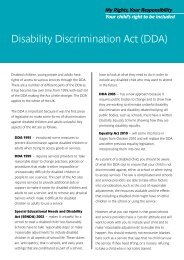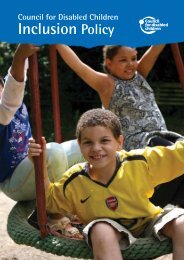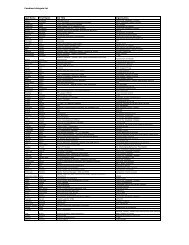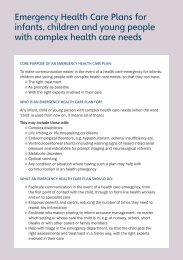Early years and the Disability Discrimination Act 1995 What service ...
Early years and the Disability Discrimination Act 1995 What service ...
Early years and the Disability Discrimination Act 1995 What service ...
Create successful ePaper yourself
Turn your PDF publications into a flip-book with our unique Google optimized e-Paper software.
<strong>Early</strong> <strong>years</strong> <strong>and</strong> <strong>the</strong> <strong>Disability</strong> <strong>Discrimination</strong> <strong>Act</strong> <strong>1995</strong><br />
<strong>What</strong> <strong>service</strong> providers need to know<br />
From September 2002 <strong>the</strong> <strong>Disability</strong> <strong>Discrimination</strong> <strong>Act</strong> <strong>1995</strong><br />
(DDA) applies to all providers of early <strong>years</strong> <strong>service</strong>s. This<br />
leaflet explains how <strong>the</strong> DDA applies to those providing care<br />
<strong>and</strong> education in early <strong>years</strong> settings. It provides examples of<br />
how <strong>the</strong> duties work <strong>and</strong> suggests some simple approaches that<br />
may help to ensure that disabled children are not discriminated<br />
against.<br />
<strong>Early</strong> <strong>years</strong> <strong>and</strong> <strong>the</strong><br />
<strong>Disability</strong> <strong>Discrimination</strong> <strong>Act</strong> <strong>1995</strong><br />
<strong>What</strong> <strong>service</strong> providers need to know<br />
Published by National Children’s Bureau Enterprises Ltd,<br />
<strong>the</strong> trading company of <strong>the</strong> National Children’s Bureau,<br />
8 Wakley Street, London EC1V 7QE.<br />
Registered Charity 258825. Website: www.ncb.org.uk<br />
Oc National Children’s Bureau 2003 Enterprises Ltd <strong>Early</strong> Childhood Unit
Contents<br />
1 Introduction. . . . . . . . . . . . . . . . . . . . . . . . . . . . . . . . . . . . . . . . . . . 1<br />
2 Which settings are covered by Part 4 of <strong>the</strong> DDA? . . . . . . . . . . . . . 2<br />
3 Which settings are covered by Part 3 of <strong>the</strong> DDA? . . . . . . . . . . . . . 2<br />
4 <strong>What</strong> is discrimination? . . . . . . . . . . . . . . . . . . . . . . . . . . . . . . . . . . 2<br />
5 <strong>What</strong> is ‘less favourable treatment’? . . . . . . . . . . . . . . . . . . . . . . . . 3<br />
6 <strong>What</strong> are ‘reasonable adjustments’? . . . . . . . . . . . . . . . . . . . . . . . . . 5<br />
7 How does <strong>the</strong> ‘reasonable adjustments’ duty apply to schools? . . . . 6<br />
8 How does <strong>the</strong> ‘reasonable adjustments’ duty apply to early <strong>years</strong><br />
providers o<strong>the</strong>r than schools?. . . . . . . . . . . . . . . . . . . . . . . . . . . . . . 8<br />
9 <strong>What</strong> is ‘reasonable’? . . . . . . . . . . . . . . . . . . . . . . . . . . . . . . . . . . . 9<br />
10 Which children are covered by <strong>the</strong>se duties? . . . . . . . . . . . . . . . . . 10<br />
11 Is <strong>the</strong>re a difference between disability <strong>and</strong> special<br />
educational needs? . . . . . . . . . . . . . . . . . . . . . . . . . . . . . . . . . . . . . 11<br />
12 Information <strong>and</strong> <strong>the</strong> DDA duties . . . . . . . . . . . . . . . . . . . . . . . . . . 11<br />
13 Who is responsible for ensuring that a disabled child is not<br />
discriminated against? . . . . . . . . . . . . . . . . . . . . . . . . . . . . . . . . . . 12<br />
14 <strong>What</strong> happens if a disabled child is discriminated against?. . . . . . . 13<br />
15 Preventing discrimination against a disabled child . . . . . . . . . . . . . 14<br />
16 Where can we go for additional help in meeting <strong>the</strong> duties?. . . . . . 15<br />
17 Conclusion. . . . . . . . . . . . . . . . . . . . . . . . . . . . . . . . . . . . . . . . . . . 16<br />
Fur<strong>the</strong>r information <strong>and</strong> contacts . . . . . . . . . . . . . . . . . . . . . . . . . . 17<br />
This document is intended as guidance only <strong>and</strong> should not be treated as<br />
an authoratitative interpretation of <strong>the</strong> law, which is a matter for <strong>the</strong> courts.<br />
The <strong>Early</strong> Childhood Unit at <strong>the</strong> NCB<br />
The <strong>Early</strong> Childhood Unit (ECU) was established within <strong>the</strong> National<br />
Children’s Bureau in 1988 <strong>and</strong> works nationally to link toge<strong>the</strong>r practice,<br />
research <strong>and</strong> information in support of <strong>the</strong> following aims:<br />
● to champion <strong>the</strong> holistic needs of all young children<br />
● to ensure <strong>the</strong> effective dissemination of high quality information <strong>and</strong><br />
good practice within <strong>the</strong> early <strong>years</strong> sector <strong>and</strong> to o<strong>the</strong>r interested parties<br />
● to promote <strong>and</strong> develop effective multi-agency <strong>and</strong> cross-agency<br />
partnerships, networks <strong>and</strong> o<strong>the</strong>r relationships<br />
● to develop all work in collaboration with partners inside NCB <strong>and</strong>/or in<br />
<strong>the</strong> wider early <strong>years</strong> sector<br />
● to develop specific areas of work which have been identified as<br />
important by <strong>the</strong> networks we support.<br />
Council for Disabled Children<br />
The Council for Disabled Children, (CDC) was founded in 1974 as an independent<br />
policy forum under <strong>the</strong> aegis of <strong>the</strong> National Children's Bureau in<br />
order to encourage discussion, development <strong>and</strong> dissemination of a wide<br />
range of policy <strong>and</strong> practice issues relating to <strong>service</strong> provision <strong>and</strong> support<br />
for children <strong>and</strong> young people with disabilities <strong>and</strong> special educational needs.<br />
The CDC aims to:<br />
● raise awareness of <strong>the</strong> needs of disabled children <strong>and</strong> <strong>the</strong>ir families<br />
● encourage multi-agency working <strong>and</strong> to contribute to <strong>the</strong> development<br />
of policy <strong>and</strong> practice across central <strong>and</strong> local government <strong>and</strong> child<br />
health <strong>service</strong>s<br />
● promote <strong>the</strong> positive participation of disabled children <strong>and</strong> <strong>the</strong>ir<br />
families in individual decision-making <strong>and</strong> wider policy development<br />
<strong>and</strong> <strong>service</strong> planning<br />
● provide an independent national forum for <strong>the</strong> discussion <strong>and</strong> resolution<br />
of issues relating to disabled children <strong>and</strong> <strong>the</strong>ir families.<br />
The CDC supports <strong>the</strong> Special Educational Consortium, <strong>the</strong> National<br />
Network of Parent Partnership Services <strong>and</strong> <strong>the</strong> ADSS Network for Disabled<br />
Children. It works closely with <strong>the</strong> <strong>Disability</strong> Rights Commission <strong>and</strong> a wide<br />
range of statutory, voluntary <strong>and</strong> professional bodies. Our membership is<br />
drawn from a wide range of professional, voluntary <strong>and</strong> statutory organisations<br />
<strong>and</strong> includes representation from families <strong>and</strong> disabled people.
1 Introduction<br />
From September 2002 <strong>the</strong> <strong>Disability</strong> <strong>Discrimination</strong> <strong>Act</strong> <strong>1995</strong> (DDA)<br />
applies to all providers of early <strong>years</strong> <strong>service</strong>s. This leaflet explains how<br />
<strong>the</strong> DDA applies to those providing care <strong>and</strong> education in early <strong>years</strong> settings.<br />
It provides examples of how <strong>the</strong> duties work <strong>and</strong> suggests some simple<br />
approaches that may help to ensure that disabled children are not discriminated<br />
against.<br />
The DDA has applied to <strong>the</strong> provision of childcare since it came into<br />
force in 1996. At that time education was exempt from <strong>the</strong> DDA.The<br />
Special Educational Needs <strong>and</strong> <strong>Disability</strong> <strong>Act</strong> 2001 brought in changes to<br />
both <strong>the</strong> special educational needs (SEN) legislation <strong>and</strong> to <strong>the</strong> DDA. The<br />
changes extended <strong>the</strong> coverage of <strong>the</strong> DDA to include education so that,<br />
from September 2002, it is unlawful to discriminate against disabled children<br />
in <strong>the</strong> provision of any <strong>service</strong>.<br />
This leaflet focuses on <strong>the</strong> way <strong>the</strong> DDA duties apply to <strong>the</strong> childcare<br />
<strong>and</strong> education provided in early <strong>years</strong> settings. It recognises, but does not<br />
attempt to summarise, <strong>the</strong> SEN duties. These are explained in <strong>the</strong> Special<br />
Educational Needs Code of Practice, particularly in Chapter 4, which provides<br />
guidance on <strong>the</strong> SEN responsibilities of early <strong>years</strong> settings that are<br />
in receipt of Government grant.<br />
The focus of this leaflet is on <strong>the</strong> DDA duties. It explains <strong>the</strong> duties <strong>and</strong><br />
shows how settings can comply with <strong>the</strong> legislation. It is recognised that,<br />
in many settings, <strong>the</strong> good practice that already exists goes beyond what is<br />
required under <strong>the</strong> DDA duties. The good practice that exists is recognised<br />
but is not explored in this leaflet.<br />
The DDA duties apply to all early <strong>years</strong> settings: to schools <strong>and</strong> preschools,<br />
to mainstream <strong>and</strong> to special, to private, voluntary, independent<br />
<strong>and</strong> state-maintained settings, to individual child-minders <strong>and</strong> to networks<br />
of accredited childminders, to education <strong>and</strong> social <strong>service</strong>s provision. The<br />
duties cover all providers of early <strong>years</strong> childcare <strong>and</strong> education whe<strong>the</strong>r<br />
or not <strong>the</strong>y are in receipt of government funding.<br />
There are two core duties under <strong>the</strong> DDA. These two core duties apply to<br />
all early <strong>years</strong> settings. However, <strong>the</strong>re are differences in <strong>the</strong> way <strong>the</strong> duties<br />
apply to schools <strong>and</strong> to o<strong>the</strong>r providers. The practicalities of which settings<br />
are covered by which part of <strong>the</strong> DDA are explained in sections 2 <strong>and</strong> 3.<br />
1
2 Which settings are covered by Part 4 of <strong>the</strong> DDA?<br />
Those early <strong>years</strong> settings that are constituted as schools are covered by<br />
Part 4 of <strong>the</strong> DDA. Part 4 applies to all schools: private or state-maintained,<br />
mainstream or special. The duties cover discrimination in admissions,<br />
<strong>the</strong> provision of ‘education <strong>and</strong> associated <strong>service</strong>s’ (a broad term<br />
covering <strong>the</strong> whole life of <strong>the</strong> school) <strong>and</strong> exclusions.<br />
3 Which settings are covered by Part 3 of <strong>the</strong> DDA?<br />
Part 3 of <strong>the</strong> DDA covers all providers that are not constituted as schools:<br />
day nurseries, family centres, childcare centres, pre-schools <strong>and</strong> playgroups,<br />
individual childminders <strong>and</strong> networks of accredited childminders<br />
<strong>and</strong> o<strong>the</strong>r private, voluntary <strong>and</strong> statutory provision that is not established<br />
as a school. The duties cover <strong>the</strong> refusal to provide a <strong>service</strong>, offering a<br />
lower st<strong>and</strong>ard of <strong>service</strong> or offering a <strong>service</strong> on worse terms to a<br />
disabled child.<br />
4 <strong>What</strong> is discrimination?<br />
The DDA sets out two main duties. These apply to all providers under both<br />
Parts 3 <strong>and</strong> 4. A failure to comply with <strong>the</strong>se two duties may amount to<br />
unlawful discrimination. The two key duties are:<br />
● not to treat a disabled child ‘less favourably’;<br />
● to make ‘reasonable adjustments’ for disabled children.<br />
The two duties are explained in more detail, in sections 5 <strong>and</strong> 6.<br />
2
5 <strong>What</strong> is ‘less favourable treatment’?<br />
The DDA sets out a duty not to treat a disabled child ‘less favourably’ than<br />
someone else for a reason related to <strong>the</strong>ir disability.<br />
Example 1<br />
A mo<strong>the</strong>r seeks admission to a nursery school for her son who has<br />
Hirschprung's disease. The school says that <strong>the</strong>y could not admit him until he is<br />
toilet trained. That is <strong>the</strong>ir policy for all children. Hirschprung's disease may<br />
lead to <strong>the</strong> late establishment of bowel control. The refusal to admit <strong>the</strong> boy<br />
is for a reason related to his disability <strong>and</strong> may be discriminatory.<br />
There may sometimes be justification for less favourable treatment, but<br />
it is <strong>the</strong> blanket policy in this example that is likely to make it discriminatory.<br />
The school has not explored <strong>the</strong> nature of <strong>the</strong> boy’s condition. They<br />
have not taken advice about <strong>the</strong> management of <strong>the</strong> condition, nor considered<br />
whe<strong>the</strong>r <strong>the</strong>y may be able to adapt <strong>the</strong> routine procedures that <strong>the</strong>y<br />
have in place to deal with accidents that occur from time to time for all<br />
young children.<br />
Example 2<br />
A pre-school leaves a child behind when <strong>the</strong> rest of her group goes to <strong>the</strong><br />
park to see a puppet show. The girl has learning difficulties <strong>and</strong> <strong>the</strong> staff<br />
consider that <strong>the</strong>re is no point in taking her as she will not underst<strong>and</strong> <strong>the</strong><br />
show. The decision not to take her to <strong>the</strong> show is for a reason related to her<br />
disability <strong>and</strong> may be discriminatory.<br />
In certain circumstances <strong>the</strong>re may be justification for less favourable<br />
treatment but in this example it would appear to be unlikely. The preschool<br />
does not appear to have considered how <strong>the</strong> girl might be supported<br />
in watching <strong>and</strong> enjoying <strong>the</strong> puppet show if she had accompanied <strong>the</strong><br />
o<strong>the</strong>r children, or how <strong>the</strong>y might prepare her for <strong>the</strong> show, perhaps with a<br />
picture book or with puppets played with in advance of <strong>the</strong> visit.<br />
3
Example 3<br />
A young boy with autism collects his s<strong>and</strong>wich box for his lunch <strong>and</strong> <strong>the</strong>n<br />
has to queue for a drink. He is anxious <strong>and</strong> agitated in <strong>the</strong> queue <strong>and</strong> when<br />
ano<strong>the</strong>r boy teases him he turns round <strong>and</strong> bites him. It is a severe bite<br />
<strong>and</strong> <strong>the</strong> young boy with autism is excluded from <strong>the</strong> setting.<br />
The boy is excluded because he bit <strong>the</strong> o<strong>the</strong>r child. The question is<br />
whe<strong>the</strong>r biting <strong>the</strong> o<strong>the</strong>r child was linked to <strong>the</strong> nature of his disability.<br />
Some of <strong>the</strong> features of his autism are that:<br />
● he finds it difficult to be so close to <strong>the</strong> o<strong>the</strong>r children;<br />
● he does not underst<strong>and</strong> <strong>the</strong> purpose of a queue;<br />
● he does not know how to cope with <strong>the</strong> taunt from <strong>the</strong> o<strong>the</strong>r boy.<br />
It is possible that his reaction is related to <strong>the</strong> nature of his autism <strong>and</strong><br />
<strong>the</strong>refore <strong>the</strong> exclusion may be less favourable treatment for a reason<br />
related to his disability.<br />
In certain circumstances, <strong>the</strong>re may be justification for treating a<br />
disabled child less favourably. Less favourable treatment may be justified<br />
where <strong>the</strong>re is a ‘material <strong>and</strong> substantial’ reason. Biting ano<strong>the</strong>r child<br />
might count as a ‘material <strong>and</strong> substantial’ reason, but <strong>the</strong>re is a fur<strong>the</strong>r<br />
consideration: it may not be possible to justify less favourable treatment if<br />
‘reasonable adjustments’ could have been made but were not. ‘Reasonable<br />
adjustments’ in this situation might have been:<br />
●<br />
●<br />
putting <strong>the</strong> drinks ready on <strong>the</strong> table before lunch, at least for <strong>the</strong><br />
boy with autism, so as to avoid <strong>the</strong> queuing;<br />
giving <strong>the</strong> boy a safe place to go to when he gets too anxious;<br />
● training staff in underst<strong>and</strong>ing <strong>the</strong> nature of his autism.<br />
If <strong>the</strong> setting had done all <strong>the</strong>se things <strong>and</strong> <strong>the</strong> incident had still occurred,<br />
<strong>the</strong> exclusion may have been justified, but if <strong>the</strong>y had not done any of<br />
<strong>the</strong>se things <strong>the</strong>y may not be able to justify <strong>the</strong> less favourable treatment of<br />
<strong>the</strong> disabled boy.<br />
4
6 <strong>What</strong> are ‘reasonable adjustments’?<br />
The DDA requires schools <strong>and</strong> o<strong>the</strong>r providers to make ‘reasonable<br />
adjustments’ for disabled children. The duties are ‘anticipatory’, that is<br />
schools <strong>and</strong> o<strong>the</strong>r providers need to think ahead <strong>and</strong> consider what <strong>the</strong>y<br />
may need to do for disabled children before any problems arise. The<br />
following are some examples of adjustments that have been made for<br />
disabled children to ensure that <strong>the</strong>y can be included in <strong>the</strong> life of <strong>the</strong><br />
setting as fully as possible.<br />
Example 4<br />
A pre-school checks its policies, including its admissions policy, <strong>and</strong><br />
makes some changes to ensure that conditions in <strong>the</strong> policy do not<br />
discriminate against disabled children.<br />
Example 5<br />
Two hearing impaired children are going to be admitted to a nursery<br />
education centre. The centre:<br />
●<br />
●<br />
●<br />
●<br />
arranges training for staff in <strong>the</strong> appropriate use of radio aids;<br />
draws up guidance for staff in <strong>the</strong> light of <strong>the</strong> training. This includes<br />
guidance on <strong>the</strong> use of radio microphones, <strong>the</strong> transfer of microphones<br />
to o<strong>the</strong>r children at group times, <strong>and</strong> checking that <strong>the</strong> children’s aids<br />
are set correctly for different activities;<br />
changes <strong>the</strong> location of <strong>the</strong> book corner. The rooms in this centre have<br />
large windows down one side. Staff decide to change <strong>the</strong> location of<br />
<strong>the</strong> book corner so that, at story times <strong>and</strong> at o<strong>the</strong>r times when <strong>the</strong><br />
children come toge<strong>the</strong>r as a group, <strong>the</strong> natural light illuminates <strong>the</strong> face,<br />
mouth <strong>and</strong> gestures of <strong>the</strong> staff talking to <strong>the</strong> children;<br />
pays particular attention to having visual prompts to h<strong>and</strong> when <strong>the</strong>y are<br />
planning activities with <strong>the</strong> children <strong>and</strong> using puppets <strong>and</strong> o<strong>the</strong>r props<br />
at story times.<br />
5
Example 6<br />
A child with an egg allergy is going to be admitted to a nursery class in a<br />
primary school. The school:<br />
● puts in place special meal-time arrangements which will be supervised<br />
by named staff;<br />
● arranges for a nurse to come in <strong>and</strong> train staff;<br />
● extends <strong>the</strong>ir insurance to indemnify staff who volunteer to administer<br />
emergency medication.<br />
Example 7<br />
A childminder is going to provide for a child with a physical impairment. The<br />
child uses a st<strong>and</strong>ing frame for parts of <strong>the</strong> day. The childminder thinks that<br />
it may be unsafe to let <strong>the</strong> child go in <strong>and</strong> out of <strong>the</strong> house <strong>and</strong> it may be<br />
difficult for her to play on some of <strong>the</strong> outdoor toys. At an early visit <strong>the</strong><br />
childminder invites <strong>the</strong> parents to look at <strong>the</strong> question of access <strong>and</strong> at <strong>the</strong><br />
outdoor toys that are available. Between <strong>the</strong>m <strong>the</strong>y assess <strong>the</strong> risks<br />
involved in getting up <strong>and</strong> down <strong>the</strong> steps to <strong>the</strong> outside area <strong>and</strong> <strong>the</strong>y consider<br />
which equipment may help <strong>the</strong> child by encouraging particular activities<br />
<strong>and</strong> which might present a risk. They agree a plan <strong>and</strong> <strong>the</strong> parents seek<br />
<strong>the</strong> views of <strong>the</strong> occupational <strong>the</strong>rapist at <strong>the</strong>ir next visit. When <strong>the</strong> child<br />
starts <strong>the</strong> placement, <strong>the</strong> childminder knows how <strong>the</strong> child can get in <strong>and</strong><br />
out <strong>and</strong> which equipment she should be encouraged to use.<br />
7 How does <strong>the</strong> ‘reasonable adjustments’ duty apply to schools?<br />
The DDA requires schools to make ‘reasonable adjustments’ to make sure<br />
that disabled children are not at a substantial disadvantage. However, <strong>the</strong><br />
‘reasonable adjustments’ duty does not require schools to:<br />
● provide auxiliary aids <strong>and</strong> <strong>service</strong>s;<br />
● make physical changes to buildings.<br />
For schools <strong>the</strong>se two requirements are covered by o<strong>the</strong>r parts of <strong>the</strong><br />
legislation.<br />
6
Auxiliary aids <strong>and</strong> <strong>service</strong>s<br />
Schools’ duties sit alongside <strong>the</strong> SEN Framework. It is <strong>the</strong> SEN Framework<br />
that requires schools <strong>and</strong>, where necessary, <strong>the</strong> local education authority<br />
(LEA) to make provision to meet <strong>the</strong> SEN of disabled children. This provision<br />
includes what <strong>the</strong> DDA describes as ‘auxiliary aids <strong>and</strong> <strong>service</strong>s’.<br />
Physical alterations<br />
Again, whilst schools are not required to make physical alterations as part<br />
of <strong>the</strong> disability discrimination duties, <strong>the</strong>re are requirements on schools<br />
under <strong>the</strong> ‘Planning duties’ to develop plans to improve accessibility for<br />
disabled children over time. There are similar duties on local education<br />
authorities. These plans have to be published by April 2003 <strong>and</strong> must show<br />
how schools are going to make improvements in three areas:<br />
●<br />
●<br />
●<br />
improvements in access to <strong>the</strong> curriculum;<br />
physical improvements to increase access to <strong>the</strong> buildings;<br />
improvements in <strong>the</strong> provision of information in different formats<br />
for disabled children.<br />
Ofsted will inspect school <strong>and</strong> LEA compliance with <strong>the</strong> duties from<br />
September 2002.<br />
Fur<strong>the</strong>r guidance<br />
A Code of Practice for Schools has been produced to explain schools’ duties.<br />
The Code is produced by <strong>the</strong> <strong>Disability</strong> Rights Commission <strong>and</strong> includes a<br />
wide range of helpful examples to illustrate <strong>the</strong> duties. The Commission also<br />
produces a shorter Guide for Schools <strong>and</strong> a Guide for Parents. Contact<br />
information for <strong>the</strong> Commission appears at <strong>the</strong> end of this leaflet.<br />
The Department for Education <strong>and</strong> Skills (DfES) provides guidance on<br />
<strong>the</strong> Planning duties. A summary of Accessible Schools: Planning to increase<br />
access to schools for disabled pupils has been sent to every school in Engl<strong>and</strong>.<br />
Fur<strong>the</strong>r copies of <strong>the</strong> summary, <strong>and</strong> <strong>the</strong> full version of <strong>the</strong> guidance, are<br />
available from <strong>the</strong> DfES (contact information at <strong>the</strong> end of this leaflet).<br />
7
8 How does <strong>the</strong> ‘reasonable adjustments’ duty apply to early <strong>years</strong><br />
providers o<strong>the</strong>r than schools?<br />
The duties in Part 3 of <strong>the</strong> DDA apply to providers of <strong>service</strong>s who are<br />
not constituted as schools. The Part 3 duties require providers to make<br />
‘reasonable adjustments’ to policies, practices <strong>and</strong> procedures that make it<br />
impossible or unreasonably difficult for young disabled children to make<br />
use of a <strong>service</strong>. The ‘reasonable adjustments’ duty in Part 3 includes:<br />
●<br />
<strong>the</strong> provision of auxiliary aids <strong>and</strong> <strong>service</strong>s;<br />
●<br />
from October 2004, making physical alterations to buildings.<br />
Whilst <strong>the</strong> inclusion of <strong>the</strong>se duties for providers that are not schools may<br />
make <strong>the</strong>m look more dem<strong>and</strong>ing than <strong>the</strong> schools’ duties, <strong>the</strong>re are o<strong>the</strong>r<br />
considerations to be taken into account.<br />
Any adjustments to be made for young disabled children are covered<br />
by <strong>the</strong> concept of ‘reasonableness’ which is explored in section 9. So, for<br />
example: <strong>the</strong> cost of taking a particular step can be taken into account<br />
alongside a consideration of <strong>the</strong> resources available to <strong>the</strong> setting.<br />
In meeting <strong>the</strong> requirement to provide auxiliary aids <strong>and</strong> <strong>service</strong>s for<br />
young disabled children, providers will need to draw on <strong>the</strong>ir own resources.<br />
However, whilst <strong>the</strong> legislation is clear about <strong>the</strong> direct duty on providers, in<br />
practical terms providers may be able to draw on <strong>the</strong> SEN Framework for<br />
support beyond that which providers might reasonably be expected to make<br />
<strong>the</strong>mselves. Support may be available through <strong>the</strong> <strong>Early</strong> Years Development<br />
<strong>and</strong> Childcare Partnership (EYDCP), <strong>the</strong> Special Educational Needs Coordinator<br />
(SENCO) networks <strong>and</strong> o<strong>the</strong>r <strong>service</strong>s provided in <strong>the</strong> early <strong>years</strong> by<br />
<strong>the</strong> LEA , <strong>the</strong> local social <strong>service</strong>s department <strong>and</strong> local health agencies.<br />
Providers are already required to make a <strong>service</strong> available by a<br />
reasonable alternative method where a physical feature makes it impossible<br />
or unreasonably difficult for a disabled child to access <strong>the</strong> <strong>service</strong>.<br />
Reasonable alternatives might include using a different entrance, providing<br />
a portable ramp or changing round <strong>the</strong> use of rooms inside a building. The<br />
concept of ‘reasonableness’ still applies to such arrangements.<br />
Where, after 2004, <strong>the</strong> small budgets of some providers may limit what<br />
physical alterations <strong>the</strong>y might be required to make, <strong>the</strong> duty to provide<br />
access by an alternative means continues, subject again to <strong>the</strong> concept of<br />
‘reasonableness’.<br />
8
Even where providers use rented premises, from 2004 <strong>the</strong>y may have<br />
responsibility for making physical alterations, but, depending on <strong>the</strong> use of<br />
<strong>the</strong> rest of <strong>the</strong> building <strong>and</strong> on <strong>the</strong> use of <strong>the</strong> building at o<strong>the</strong>r times, <strong>the</strong><br />
l<strong>and</strong>lord may also have responsibilities. Again, providers have to do what<br />
it is ‘reasonable’ to do.<br />
Fur<strong>the</strong>r guidance<br />
A code of practice published by <strong>the</strong> <strong>Disability</strong> Rights Commission, Code<br />
of Practice: Rights of Access: Goods, Facilities, Services <strong>and</strong> Premises,<br />
provides general guidance on how Part 3 applies to all providers of <strong>service</strong>s.<br />
It is available from <strong>the</strong> Commission.<br />
9 <strong>What</strong> is ‘reasonable’?<br />
In addition to <strong>the</strong> specific considerations, above, of what is covered by <strong>the</strong><br />
reasonable adjustments duty under Part 3 <strong>and</strong> under Part 4, <strong>the</strong>re are some<br />
general considerations about what is ‘reasonable’. Some of <strong>the</strong>se apply<br />
across both Parts 3 <strong>and</strong> 4. ‘Reasonableness’ takes account of a number of<br />
factors: costs <strong>and</strong> available resources, health <strong>and</strong> safety, <strong>the</strong> interests of o<strong>the</strong>r<br />
children <strong>and</strong> o<strong>the</strong>r considerations. Settings can take <strong>the</strong>se considerations into<br />
account when <strong>the</strong>y plan what <strong>the</strong>y may need to do for disabled children.<br />
Costs <strong>and</strong> resources<br />
The cost of making a particular adjustment may be seen in <strong>the</strong> light of <strong>the</strong><br />
resources available to <strong>the</strong> setting, so that an individual childminder or a<br />
small setting with a small budget may not be expected to make adjustments<br />
that might be expected of a larger setting with a larger budget.<br />
Health <strong>and</strong> safety<br />
For any adjustment that may have health <strong>and</strong> safety implications a setting<br />
would be well advised to carry out a risk assessment with a view to eliminating<br />
or minimising <strong>the</strong> risks involved. A setting should write down what<br />
risks <strong>the</strong>y have identified <strong>and</strong> how <strong>the</strong>se will be addressed. Where difficult<br />
issues arise it may be important to get a view from outside <strong>the</strong> setting.<br />
Health <strong>and</strong> safety considerations should not be seen as automatic barriers to<br />
disabled children. Instead <strong>the</strong>y should help to determine how to include<br />
disabled children safely in <strong>the</strong> life of <strong>the</strong> setting. Ultimately, <strong>the</strong>se<br />
considerations do not relieve <strong>the</strong> setting of identifying reasonable adjustments.<br />
They do affect decisions about which reasonable adjustment should be made.<br />
9
Justification<br />
As with <strong>the</strong> less favourable treatment duty <strong>the</strong>re may be justification for<br />
failing to make a reasonable adjustment. A setting may be able to justify a<br />
failure to make a reasonable adjustment, but only ‘for a material <strong>and</strong><br />
substantial reason’.<br />
Fur<strong>the</strong>r guidance<br />
These general considerations apply to schools <strong>and</strong> to o<strong>the</strong>r providers.<br />
More detailed guidance on what is reasonable is provided in <strong>the</strong> codes of<br />
practice: <strong>the</strong> Code of Practice for Schools <strong>and</strong> <strong>the</strong> Code of Practice: Rights<br />
of Access: Goods, Facilities, Services <strong>and</strong> Premises.<br />
10 Which children are covered by <strong>the</strong>se duties?<br />
Children covered by <strong>the</strong>se duties are those defined as disabled in <strong>the</strong> DDA.<br />
The DDA defines disability as:<br />
a physical or mental impairment which has a substantial <strong>and</strong> longterm<br />
adverse effect on a person’s ability to perform normal day-to-day<br />
activities.<br />
The definition includes a wide range of impairments, including hidden<br />
impairments. If, for example, a child has an impairment affecting <strong>the</strong>ir<br />
mobility, sight or hearing, or has learning difficulties, mental health<br />
problems, epilepsy, autism, a speech <strong>and</strong> language impairment, asthma,<br />
diabetes or HIV, <strong>the</strong>n he or she may have a disability if <strong>the</strong> effect of <strong>the</strong><br />
impairment on <strong>the</strong> child’s ability to carry out normal day-to-day activities<br />
is ‘substantial’ <strong>and</strong> ‘long-term’. ‘Substantial’ in <strong>the</strong> DDA means ‘more<br />
than minor or trivial’. ‘Long-term’ means that <strong>the</strong> impairment has lasted at<br />
least a year, or is likely to last for at least a year.<br />
The effect of all <strong>the</strong>se different elements in <strong>the</strong> definition is to include a<br />
very large group of children within <strong>the</strong> definition of disability.<br />
Questions often arise about whe<strong>the</strong>r children with behaviour difficulties<br />
are included in <strong>the</strong> definition. A child may have significant behaviour difficulties<br />
<strong>and</strong> <strong>the</strong>se may relate to an underlying impairment. If <strong>the</strong>y do, <strong>the</strong><br />
child may count as disabled because of <strong>the</strong> underlying impairment.<br />
10
11 Is <strong>the</strong>re a difference between disability <strong>and</strong> special<br />
educational needs?<br />
Yes, <strong>the</strong>re is a difference. SEN are defined in Part 4 of <strong>the</strong> Education <strong>Act</strong><br />
1996, <strong>the</strong> main SEN legislation. This definition is used throughout <strong>the</strong><br />
SEN legislation. <strong>Disability</strong> is defined in <strong>the</strong> DDA <strong>and</strong> it is this definition<br />
that is used as <strong>the</strong> basis for <strong>the</strong> duties in <strong>the</strong> DDA.<br />
In practice, many children who have SEN will also be defined as having<br />
a disability under <strong>the</strong> DDA. However, not all children who are disabled<br />
have SEN. For example, those with severe asthma, arthritis or diabetes<br />
may not have SEN but may have rights under <strong>the</strong> DDA. Similarly, not all<br />
children with SEN will be defined as having a disability under <strong>the</strong> DDA.<br />
However, it is important to remember that, under <strong>the</strong> SEN legislation, a disabled<br />
child has SEN, by definition, if <strong>the</strong>y need any provision to be made<br />
for <strong>the</strong>m to enable <strong>the</strong>m to access <strong>the</strong> education that is available locally.<br />
12 Information <strong>and</strong> <strong>the</strong> DDA duties<br />
The ‘reasonable adjustments’ duty is ‘anticipatory.’ This means that all<br />
settings will need to review <strong>the</strong>ir policies, practices <strong>and</strong> procedures to ensure<br />
that <strong>the</strong>se would not discriminate against any disabled children. This should<br />
be done whe<strong>the</strong>r or not <strong>the</strong> setting knows of any disabled children on <strong>the</strong>ir<br />
current roll, or seeking admission. For some children, or groups of children,<br />
specific changes may be needed as well as more general changes.<br />
In deciding what adjustments may need to be made, it is important that<br />
settings seek information from parents before a child is admitted, so that <strong>the</strong><br />
necessary adjustments can be put in place in good time. If, despite opportunities<br />
<strong>and</strong> encouragement, <strong>the</strong> parents have chosen not to share this information,<br />
<strong>the</strong> setting may be able to claim <strong>the</strong>y did not know about <strong>the</strong> disability.<br />
A setting would only be able to claim this if <strong>the</strong>y had taken reasonable steps<br />
to find out about <strong>the</strong> existence of, or nature of, a child’s disability.<br />
If a parent does share information about <strong>the</strong>ir child’s disability, but asks<br />
<strong>the</strong> manager or head teacher to keep that information confidential, this<br />
may limit what ‘reasonable adjustments’ can be made for this child. The<br />
duties recognise this.<br />
11
13 Who is responsible for ensuring a child is not discriminated against?<br />
Responsibility for <strong>the</strong> Part 4 duties<br />
Responsibility for <strong>the</strong> Part 4 (schools’ duties) lies with <strong>the</strong> ‘responsible<br />
body’ for <strong>the</strong> school. This is likely to be <strong>the</strong> governing body of a statemaintained<br />
school or <strong>the</strong> ‘proprietor’ (<strong>the</strong> owner, <strong>the</strong> governing body, <strong>the</strong><br />
management group or <strong>the</strong> trustees) of a private or independent school,<br />
though in <strong>the</strong> case of an LEA nursery school it is <strong>the</strong> LEA. Where <strong>the</strong> LEA<br />
has responsibility for admissions, for example, admissions to community<br />
schools, or where <strong>the</strong> LEA provides Portage, or o<strong>the</strong>r home visiting<br />
<strong>service</strong>s, it is also <strong>the</strong> LEA that is <strong>the</strong> responsible body.<br />
More detail about ‘responsible bodies’ under <strong>the</strong> schools’ duties can be<br />
found in <strong>the</strong> <strong>Disability</strong> Rights Commission’s Code of Practice for Schools.<br />
Responsibility for <strong>the</strong> Part 3 duties<br />
Under Part 3 it is <strong>the</strong> individual or <strong>the</strong> organisation that provides <strong>the</strong> <strong>service</strong><br />
who has responsibility for <strong>the</strong> DDA duties, whe<strong>the</strong>r <strong>the</strong>y are in <strong>the</strong> private,<br />
public or voluntary sector <strong>and</strong> whe<strong>the</strong>r <strong>the</strong> <strong>service</strong>s are provided free or in<br />
return for payment. For a pre-school, playgroup or o<strong>the</strong>r voluntary group it<br />
is likely to be <strong>the</strong> management group for <strong>the</strong> particular setting or <strong>the</strong> organisation<br />
responsible for <strong>the</strong> <strong>service</strong>; for provision run by a social <strong>service</strong>s<br />
department it is likely to be <strong>the</strong> social <strong>service</strong>s department; for an individual<br />
childminder it is <strong>the</strong> childminder him or herself; for childminders working<br />
within a network it is likely to be both those who are responsible for <strong>the</strong> network<br />
<strong>and</strong> individual childminders in relation to <strong>the</strong>ir respective responsibilities.<br />
More detail about <strong>the</strong> duties on <strong>service</strong> providers under Part 3 of <strong>the</strong><br />
DDA can be found in <strong>the</strong> <strong>Disability</strong> Rights Commission’s Code of<br />
Practice: Rights of Access: Goods, Facilities, Services <strong>and</strong> Premises.<br />
Considerations under Part 3 <strong>and</strong> Part 4<br />
It is important to recognise that, though <strong>the</strong> provider or <strong>the</strong> ‘responsible<br />
body’ is responsible for ensuring that disabled children are not discriminated<br />
against, anyone working in a setting could expose it to a claim of<br />
discrimination: a volunteer or a member of staff, a manager or a trainee, a<br />
teacher, an assistant or an administrator. It follows that it will be important<br />
that those working in a setting, whe<strong>the</strong>r paid or unpaid, underst<strong>and</strong> <strong>the</strong><br />
duties towards disabled children <strong>and</strong> know about <strong>the</strong> ‘reasonable adjustments’<br />
that need to be made for particular children.<br />
12
14 <strong>What</strong> happens if a disabled child is discriminated against?<br />
Where <strong>the</strong>re has been unlawful discrimination <strong>the</strong>re is a means of redress.<br />
Part 4<br />
A claim of unlawful discrimination under Part 4 of <strong>the</strong> DDA:<br />
●<br />
●<br />
●<br />
is made by <strong>the</strong> parent of a disabled child;<br />
<strong>the</strong> claim is made to <strong>the</strong> SEN <strong>and</strong> <strong>Disability</strong> Tribunal, or in certain<br />
cases to a local admissions or exclusions appeal panel;<br />
if <strong>the</strong> SEN <strong>and</strong> <strong>Disability</strong> Tribunal determines that <strong>the</strong>re has been<br />
unlawful discrimination, it can order any remedy it sees fit, but no<br />
financial compensation is available.<br />
Part 3<br />
Where <strong>service</strong>s are covered by Part 3 of <strong>the</strong> DDA (providers o<strong>the</strong>r than schools):<br />
● a claim of discrimination is heard in <strong>the</strong> County Court;<br />
● if <strong>the</strong> Court determines that <strong>the</strong>re has been unlawful discrimination, <strong>the</strong><br />
remedies available include financial compensation.<br />
Under Parts 3 <strong>and</strong> 4<br />
There are many sensible measures that settings can put in place to prevent a<br />
difficulty becoming a claim of discrimination. Firstly, it is good practice<br />
(<strong>and</strong>, where <strong>the</strong> setting is in receipt of government grant, a necessary part of<br />
a settting’s SEN policy) to have a complaints procedure that is widely known<br />
to parents. A complaints procedure usually starts by asking parents to raise<br />
any difficulty with <strong>the</strong> person in charge. If this does not lead to <strong>the</strong><br />
resolution of <strong>the</strong> difficulty, <strong>the</strong> procedure is usually to take <strong>the</strong> complaint to<br />
<strong>the</strong> management group, governing body, proprietor or, in some cases, to <strong>the</strong><br />
LEA. Beyond this, <strong>the</strong> <strong>Disability</strong> Rights Commission may be able to help.<br />
The Commission provides a confidential help line, with access to information<br />
<strong>and</strong> advice for providers, parents <strong>and</strong> disabled people. In addition, <strong>the</strong><br />
Commission runs a conciliation <strong>service</strong>. This <strong>service</strong> may be able to assist<br />
in <strong>the</strong> resolution of <strong>the</strong> difficulty without <strong>the</strong> need to go to <strong>the</strong> courts or to<br />
<strong>the</strong> SEN <strong>and</strong> <strong>Disability</strong> Tribunal. Using <strong>the</strong> Commission’s conciliation<br />
<strong>service</strong> does not affect parents’ recourse to <strong>the</strong> courts or to <strong>the</strong> Tribunal.<br />
Contact information is provided at <strong>the</strong> end of this leaflet.<br />
13
15 Preventing discrimination against a disabled child<br />
Many early <strong>years</strong> providers have already been working with <strong>the</strong>ir <strong>Early</strong><br />
Years Development <strong>and</strong> Childcare Partnership (EYDCP) to ensure that<br />
disabled children can be admitted to <strong>the</strong> placement that <strong>the</strong>ir parents are<br />
seeking for <strong>the</strong>m. Many providers are also working with parents <strong>and</strong> early<br />
<strong>years</strong> advisory staff to ensure that disabled children can join in <strong>the</strong> full<br />
range of activities offered in <strong>the</strong>ir chosen setting. Many providers have<br />
already seen <strong>the</strong> benefits, for all children, of working in this way.<br />
Those who are working towards ensuring equal opportunities for young<br />
disabled children are not likely to have any difficulty in complying with<br />
<strong>the</strong> duties in <strong>the</strong> DDA. However, <strong>the</strong>re are some things that all providers<br />
would sensibly do to reduce <strong>the</strong> likelihood that <strong>the</strong>y might discriminate<br />
against a disabled child.<br />
Training<br />
Clearly it is important that <strong>the</strong> senior staff in any setting are aware of <strong>and</strong><br />
underst<strong>and</strong> <strong>the</strong> duties towards disabled children. It is also important that all<br />
staff <strong>and</strong> volunteers are aware of <strong>the</strong> DDA duties, of <strong>the</strong> main principles in<br />
<strong>the</strong> legislation, <strong>and</strong> underst<strong>and</strong> disability as an equality issue. Training will<br />
be an important element in raising awareness of <strong>the</strong> duties <strong>and</strong> of <strong>the</strong> disability<br />
equality issues on which <strong>the</strong>y are based. The local EYDCP will be<br />
able to tell settings what training is being provided locally.<br />
Reviewing<br />
An important part of meeting <strong>the</strong> duties will be ensuring that settings do not<br />
inadvertently discriminate against disabled children. If all settings recognise<br />
that <strong>the</strong>y already have disabled children on roll, or are likely to admit <strong>the</strong>m,<br />
<strong>the</strong>n one of <strong>the</strong> key things that <strong>the</strong>y will want to do is to review <strong>the</strong>ir<br />
policies, practices <strong>and</strong> procedures <strong>and</strong> revise <strong>the</strong>m where necessary. In doing<br />
this <strong>the</strong>y will sensibly look across all <strong>the</strong> different areas of <strong>the</strong> life of <strong>the</strong><br />
setting, <strong>and</strong> may want to check <strong>the</strong>ir admissions policy in particular.<br />
Finding out<br />
Information is a crucial part of meeting <strong>the</strong> DDA duties. Providers will<br />
want to make sure that <strong>the</strong>y provide opportunities for parents, <strong>and</strong> disabled<br />
children <strong>the</strong>mselves, to share information about possible or actual barriers,<br />
<strong>and</strong> <strong>the</strong> sort of adjustments that may need to be made to remove <strong>the</strong>se<br />
14
arriers. An important part of encouraging <strong>the</strong> sharing of information will<br />
be developing parents’ trust that information that <strong>the</strong>y share will be<br />
h<strong>and</strong>led sensitively. Such trust is more likely to develop where parents<br />
encounter a welcome, ra<strong>the</strong>r than resistance to <strong>the</strong>ir child, a willingness to<br />
explore possibilities ra<strong>the</strong>r than a refusal to consider <strong>the</strong>m.<br />
16 Where can we go for additional help in meeting <strong>the</strong> duties?<br />
As well as drawing on <strong>the</strong> information that parents hold about <strong>the</strong>ir child,<br />
settings will want to explore what o<strong>the</strong>r sources of support may be<br />
available to <strong>the</strong>m. A range of <strong>service</strong>s may be available, but <strong>the</strong>se are<br />
likely to vary from area to area.<br />
Special Educational Needs Coordinator Networks<br />
One of <strong>the</strong> key functions of <strong>the</strong> Area SENCOs <strong>and</strong> <strong>the</strong> SENCO networks is<br />
to provide advice on <strong>and</strong> access to <strong>the</strong> <strong>service</strong>s that may be able to offer<br />
additional support for young children in early <strong>years</strong> settings. These <strong>service</strong>s<br />
<strong>the</strong>mselves will vary from area to area but <strong>the</strong> Area SENCO, <strong>the</strong> local<br />
EYDCP <strong>and</strong> <strong>the</strong> LEA will be key points of contact.<br />
Training<br />
A range of training is usually available to early <strong>years</strong> providers. The local<br />
EYDCP holds information about training <strong>and</strong>, in many areas, will be able<br />
to support settings in considering what <strong>the</strong>ir training needs are. Much of <strong>the</strong><br />
training that is available locally can count towards national qualifications.<br />
Special <strong>service</strong>s <strong>and</strong> funding<br />
In some areas special <strong>service</strong>s are available to early <strong>years</strong> settings. In one<br />
area <strong>the</strong> local Portage home visiting team provides advice <strong>and</strong> support for<br />
early <strong>years</strong> settings outside <strong>the</strong> maintained sector. The same <strong>service</strong> also<br />
provides a telephone surgery <strong>service</strong> that enables settings to raise concerns<br />
that may be followed up with a visit.<br />
In some areas funding is available to support work with young children<br />
with SEN <strong>and</strong> disabilities. Funding arrangements change over time, so it is<br />
important to check with your LEA or EYDCP on what is available.<br />
15
Equipment <strong>and</strong> toy collections for loan<br />
In many areas toy collections are available for loan to early <strong>years</strong> settings.<br />
In some areas <strong>the</strong>se have been extended to include resources <strong>and</strong> equipment<br />
that can be made available for loan to provide access <strong>and</strong> opportunities<br />
for young children with SEN <strong>and</strong> disabilities.<br />
Health <strong>and</strong> social <strong>service</strong>s support<br />
Settings may have local arrangements for contacting a range of agencies<br />
directly. In some areas link health clinics have been identified for<br />
providers to contact directly. In some areas a local Child Development<br />
Centre may provide a contact point for consulting a range of different<br />
<strong>service</strong>s: community nurses, clinical psychologists, occupational <strong>the</strong>rapy<br />
<strong>service</strong>s. Many social <strong>service</strong>s departments have specialist Children with<br />
Disabilities Teams, who can offer advice <strong>and</strong> family support, for example:<br />
transport, an occupational <strong>the</strong>rapy <strong>service</strong>, or <strong>the</strong> loan of equipment.<br />
Voluntary organisations <strong>and</strong> parent partnership <strong>service</strong>s<br />
Voluntary organisations may be able to provide information <strong>and</strong> advice on<br />
a range of issues. Local parent partnership <strong>service</strong>s may be a useful point<br />
of contact, many of <strong>the</strong>m keep directories of voluntary organisations in <strong>the</strong><br />
local area. As well as being able to provide pointers to voluntary<br />
organisations parent partnership <strong>service</strong>s <strong>the</strong>mselves provide information<br />
<strong>and</strong> support directly to parents.<br />
17 Conclusion<br />
The DDA duties now apply to every area of early <strong>years</strong> provision. The<br />
duties sit alongside <strong>the</strong> SEN Framework <strong>and</strong> <strong>the</strong> work that is developing<br />
through <strong>the</strong> SEN Code of Practice <strong>and</strong> <strong>the</strong> SENCO Networks.<br />
Toge<strong>the</strong>r, <strong>the</strong>se duties are designed to provide a stronger legal<br />
framework to underpin equality of opportunity for young disabled<br />
children. Settings that are already committed to <strong>and</strong> striving for equal<br />
opportunities <strong>and</strong> inclusion are unlikely to face difficulties in meeting<br />
<strong>the</strong> duties. <strong>What</strong> is required of all settings is ‘reasonable’ in all <strong>the</strong><br />
circumstances of <strong>the</strong> case.<br />
16
Fur<strong>the</strong>r information <strong>and</strong> contacts<br />
Part 4 duties<br />
More detailed guidance on <strong>the</strong> schools’ duties under Part 4 of <strong>the</strong> DDA is<br />
set out in <strong>the</strong> <strong>Disability</strong> Rights Commission’s Code of Practice for Schools<br />
(2002). This Code is available from <strong>the</strong> Commission’s Helpline.<br />
The <strong>Disability</strong> Rights Commission has also produced shorter booklets for<br />
schools <strong>and</strong> for parents: A Guide for Schools <strong>and</strong> A Guide for Parents.<br />
These are also available from <strong>the</strong> Commission’s Helpline.<br />
Part 3 duties<br />
More detailed guidance on <strong>the</strong> duties on providers of <strong>service</strong>s under Part 3<br />
of <strong>the</strong> DDA is available in <strong>the</strong> <strong>Disability</strong> Rights Commission’s Code of<br />
Practice: Rights of Access: Goods, Facilities, Services <strong>and</strong> Premises (2002).<br />
The Code of Practice on Part 3 is a priced item. The Code provides a<br />
detailed account of how <strong>the</strong> duties apply. However, it draws examples<br />
primarily from a range of <strong>service</strong>s provided to disabled adults. The<br />
Council for Disabled Children has been commissioned by <strong>the</strong> Department<br />
of Health to draft guidance on how <strong>the</strong> Part 3 duties apply to children’s<br />
<strong>service</strong>s. This guidance will be published in Spring 2003.<br />
The <strong>Disability</strong> Rights Commission<br />
The <strong>Disability</strong> Rights Commission provides a range of information <strong>and</strong><br />
guidance on <strong>the</strong> DDA. The <strong>Disability</strong> Rights Commission can be contacted<br />
at:<br />
Telephone: 08457 622 633<br />
Textphone: 08457 622 644<br />
Fax: 08457 778 878<br />
E-mail: enquiry@drc-gb.org<br />
Post: DRC Helpline, FREEPOST, MID 02164,<br />
Stratford-upon-Avon, CV37 9BR<br />
Website: www.drc-gb.org<br />
17
The SEN <strong>and</strong> <strong>Disability</strong> Tribunal<br />
The SEN <strong>and</strong> <strong>Disability</strong> Tribunal can be contacted at:<br />
Telephone: 020 7925 5750<br />
Fax: 020 7925 6786<br />
E-mail: tribunalqueries@sendist.gsi.gov.uk<br />
Post: Windsor House, 50 Victoria Street, London, SW1H 0NW<br />
Department for Education <strong>and</strong> Skills publications<br />
For publications from <strong>the</strong> Department for Education <strong>and</strong> Skills, contact:<br />
Telephone: 0845 60 222 60<br />
Fax: 0845 60 333 60<br />
E-mail: dfes@prolog.uk.com<br />
Post: DfES Publications, PO Box 5050, Sherwood Park, Annesley<br />
Nottinghamshire, NG15 0DJ<br />
18
Local contact information<br />
You may like to add here your own contact information for <strong>the</strong> local<br />
EYDCP, Children’s Information Service, Parent Partnership Service, <strong>and</strong><br />
local health, education <strong>and</strong> social <strong>service</strong>s:<br />
19


